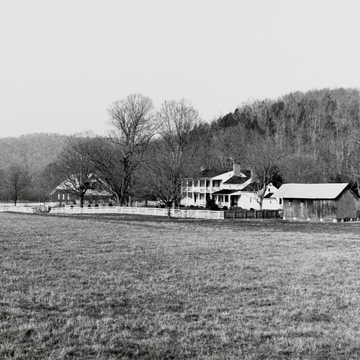Spring Valley Farm, just the sort of agricultural complex one hopes to see in such a pastoral setting, provides the perfect introduction to Monroe County for travelers coming from the north. The nucleus of the main house is a lateeighteenth-century log structure, now clapboarded. A much larger wood extension was built c. 1837–1841, in part to accommodate visitors to the nearby springs. Architecturally, the expanded house came to resemble some of the larger cottages at the spas. Henry Clay, whose host, Richard Dickson, shared his Whig political philosophy, is reported to have been a favorite guest.
A two-tiered porch, or piazza, supported by Tuscan columns covered by a shed-roofed extension of the gabled roof, extends across the main block (the 1830s addition). A Chinese Chippendale railing on the second floor, likely inspired by similarly patterned railings at Elmwood and the Sweet Springs Hotel (see entries below), provides a further note of architectural distinction. An account book that has descended, along with the property, in the family of the original owners gives details of the addition. Materials cost $1,967.00 and labor $879.13. Carpenter Sanford Ethell received payments for much of the interior woodwork.
A number of early log and frame auxiliary structures, including a stable (where a change of horses was always kept ready for travelers), granary, and smokehouse, stand near the house. An impressive bank barn, built in 1905 of framing reused from an 1870 woolen mill, stands across U.S. 219 from the other buildings.

